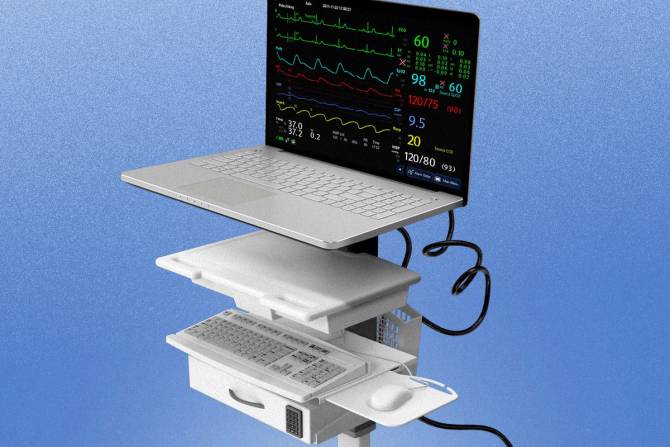Happy Monday! We’re excited to announce that our first State of the Industry Report is now available. Compiled from audience surveys and original reporting, this comprehensive analysis examines the biggest challenges hospitals are facing today, the impending changes in Big Tech’s role in the industry, and the disconnect between hospital leadership and patient-facing workers. Learn more about the report and get your copy here.
In today’s edition:
 Bladder cancer test evolves Bladder cancer test evolves
⚕️ Menopause care gaps
 Gene therapies Gene therapies
—Shannon Young, Kristine White, Maia Anderson
|
|
Magicmine/Getty Images
Screening patients for bladder cancer could soon be as easy—and painless—as an at-home pregnancy or Covid-19 test, thanks to the recent discovery of proteins that signal the disease’s early stages.
University of Houston (UH) researchers, who analyzed more than 1,300 urine sample proteins from 2020 to 2023, identified biomarkers that could help doctors detect and diagnose the disease via a simple urine test instead of a cystoscopy—an invasive procedure in which a thin camera is inserted into a patient’s urethra.
Chandra Mohan, a Hugh Roy and Lillie Cranz Cullen endowed professor of biomedical engineering at UH and the study’s lead author, told Healthcare Brew that more research is needed before a urine test can replace cystoscopy as the “gold standard” for bladder cancer diagnosis. But if adopted, the method could improve early detection of bladder cancer—one of the most common cancers diagnosed in the US—as well as patient outcomes and medical costs.
“It’s rare for somebody to send a patient for cystoscopy unless the index of suspicion [of cancer] is very high. This is a test that all you need is a urine sample. The chances are this will be done much earlier in larger numbers of patients…resulting in better identification—early identification—of bladder cancer,” Mohan said. “Of course, they would confirm that using a cystoscopy and biopsy.”
The study, which Mohan said was the first to examine such a wide range of urine sample proteins for potential biomarkers, found that one protein fragment, D-dimer, could play a role in cancer diagnosis or recurrence detection. D-dimer displayed the highest accuracy and sensitivity—at a respective 96% and 97%—of 21 urine proteins discriminating bladder cancer from urology clinic controls during the screening.
Keep reading here.—SY
Do you work in healthcare or have information about the industry that we should know? Email Shannon at shannon@morningbrew.com. For completely confidential conversations, ask Shannon for her number on Signal.
|
|
Ready to land your dream job? It all starts with a killer resume. But crafting one that truly stands out can be a daunting task. That’s why we’ve created the ultimate guide to building a strong and effective resume.
Our guide is jam-packed with practical tips and real-world examples to help you craft a resume that will impress even the toughest hiring managers. We’ll show you how to highlight your skills and experience in a way that makes you stand out from the crowd. So if you’re ready to take your career to the next level, download your copy today.
|
|
Yulia-Images/Getty Images
Menopause is overwhelmingly underdiagnosed and undertreated, leading 1+ million patients to incur higher healthcare costs each year, a new study found.
Elektra Health, a telemedicine platform aimed at treating menopause, analyzed 2021 insurance claims data from 2.6 million women between the ages of 40 and 60, and compared the healthcare spending differences between patients who received a menopause-related ICD-10 diagnosis code to those who did not.
More than 1 million people in the US go through menopause each year, but only one in five (19%) receives a menopause diagnosis, according to the study. While menopause is often self-diagnosed, providers can use blood or urine tests to check hormone levels for confirmation.
However, a lack of ob-gyn menopause training has created a “massive care gap”; many patients seeking menopause care do not receive adequate treatment and instead turn to multiple specialists for care, the study found.
“Menopause costs are hiding in plain sight, and engaging women around their menopausal health has far-reaching implications,” Elektra co-founder and CEO Alessandra Henderson said in a statement. “In this way, menopause should be considered akin to other conditions driving significant costs, such as diabetes or hypertension.”
Only 20.8% of ob-gyn residents reported that their program had a menopause medicine training curriculum, according to a 2013 survey of 510 ob-gyn residents in the US published in The Journal of The North American Menopause Society. More than 60% of those surveyed reported having limited knowledge on aspects of menopause medicine, such as understanding bone health and how menopause symptoms progress.
Lack of providers trained in menopause medicine leads to “wasteful spending on specialty visits and tests,” per the Elektra study.
Keep reading here.—KW
Do you work in healthcare or have information about the industry that we should know? Email Kristine at white@morningbrew.com. For completely confidential conversations, ask Kristine for her number on Signal.
|
|
Andrew Brookes/Getty Images
Some scientists tout gene therapies—drugs that modify a patient’s genes to treat or cure a disease—as the future of medicine, with the potential to treat the most pressing diseases like cancer, diabetes, and heart disease.
Gene therapies also have massive cost-savings potential, particularly when it comes to treating rare diseases. Most rare diseases are caused by a single gene mutation, which means a gene therapy treatment could fix the root cause of the condition.
The economic burden of rare diseases is staggering. It cost the US almost $1 trillion in 2019 from direct medical costs, non-medical and uncovered healthcare costs, and productivity loss, according to Rachel Salzman, global head of corporate strategy at precision therapeutics company Armatus Bio.
But these gene therapies come with a hefty price tag.
A gene therapy called Hemgenix, developed by CSL Behring and uniQure, costs $3.5 billion per dose. And that’s not far out of the ordinary for gene therapies. The Institute for Clinical and Economic Review estimates the average cost of gene therapy to be between $1 million and $2 million per dose.
The cost of the therapies means many patients lack access, Salzman said, speaking at the American Society of Gene and Cell Therapy’s annual meeting on May 16. Fewer than 10,000 patients received treatment with three gene therapy drugs in 2021, she said.
The three drugs—two from Novartis called Zolgensma and Kymriah, and one from Kite Pharma called Yescarta—brought in a cumulative $3.5 billion in revenue in 2021. If 10,000 patients were treated with the drugs in 2021, that translates to $350,000 in revenue per patient.
Keep reading here.—MA
Do you work in healthcare or have information about the industry that we should know? Email Maia at anderson@morningbrew.com. For completely confidential conversations, ask Maia for her number on Signal.
|
|
Francis Scialabba
Today’s top healthcare reads.
Stat: Almost 110,000 people in the US died from drug overdoses last year, according to new CDC estimates. (CNN)
Quote: “For decades, fathers and mothers have been sending children to school with low-fat chicken, turkey deli meat thinking they were doing good. These foods are toxic.”—Dariush Mozaffarian, a cardiologist and professor of nutrition and medicine at Tufts University, on the health risks of processed meats (the Wall Street Journal)
Read: Hospitals that denied abortions to patients having miscarriages are now facing legal scrutiny. (ProPublica)
|
|
-
Debt ceiling negotiations could result in less funding for state and local health officials to combat STDs.
-
Remote work is making it easier for some family caregivers to fill care gaps.
-
An RSV vaccine for pregnant women is another step closer to approval.
-
Congress will question Cigna over its practice of rejecting medical claims by the hundreds of thousands every month.
|
|
Catch up on the top Healthcare Brew stories you may have missed:
|
|
|
Written by
Shannon Young, Kristine White, and Maia Anderson
Was this email forwarded to you? Sign up
here.
{if !contains(profile.lists,"Marketing Brew") || !contains(profile.lists,"CFO Brew") || !contains(profile.lists,"HR Brew") || !contains(profile.lists,"EmTech Brew") || !contains(profile.lists,"IT Brew") || !contains(profile.lists,"Retail Brew") || !contains(profile.lists,"Healthcare Brew")}
Take The Brew to work
{/if}
{if !contains(profile.lists,"Marketing Brew")}
-
Marketers:
{if !contains(profile.lists,"Marketing Brew")}
Marketing Brew
{/if}
{/if}
{if !contains(profile.lists,"CFO Brew") || !contains(profile.lists,"HR Brew")}
-
Corporate:
{if !contains(profile.lists,"CFO Brew")}
CFO Brew
{/if}
{if !contains(profile.lists,"HR Brew")}
HR Brew
{/if}
{/if}
{if !contains(profile.lists,"EmTech Brew") || !contains(profile.lists,"IT Brew")}
-
Tech:
{if !contains(profile.lists,"IT Brew")}
IT Brew
{/if}
{if !contains(profile.lists,"EmTech Brew")}
Tech Brew
{/if}
{/if}
{if !contains(profile.lists,"Retail Brew")}
-
Retailers:
Retail Brew
{/if}
{if !contains(profile.lists,"Healthcare Brew")}
-
Healthcare:
Healthcare Brew
{/if}
{if !contains(profile.lists,"Daily Business") || !contains(profile.lists,"Money Scoop") || !contains(profile.lists,"Money With Katie")}
Get smarter in just 5 minutes
{/if}
{if !contains(profile.lists,"Daily Business")}
-
Business News:
Morning Brew
{/if}
{if !contains(profile.lists,"Money Scoop") || !contains(profile.lists,"Money With Katie") || !contains(profile.lists,"Raise")}
-
Money & Career:
{if !contains(profile.lists,"Money Scoop")}
Money Scoop
{/if}
{if !contains(profile.lists,"Money With Katie")}
Money With Katie
{/if}
{if !contains(profile.lists,"Raise")}
Raise
{/if}
{/if}
Business education without the BS
Interested in podcasts?
|
ADVERTISE
//
CAREERS
//
SHOP
//
FAQ
Update your email preferences or unsubscribe
here.
View our privacy policy
here.
Copyright ©
2023
Morning Brew. All rights reserved.
22 W 19th St, 4th Floor, New York, NY 10011
|
|







